Learning how to meditate is pretty straightforward. Our favorite seven-step meditation guide is right here!
- The Seven Simple Steps of Meditation
- Step 1: Find a Comfortable Seated Position
- See also: A Complete Guide to the 7 Chakras
- Step 2: Close Your Eyes
- Step 3: Deep Breathing
- Step 4: Scan Your Body
- Step 5: Observe Your Thoughts
- Benefits of Observing Thoughts:
- Step 6: Focus on Your Breath
- Step 7: Gradually Open Your Eyes
- Meditation as a Supportive
- Tips for Beginners:
- Conclusion
- FAQ
One effective technique that can significantly improve both our mental and physical health is meditation. Regular meditation has been shown to reduce stress, increase mental clarity, and even improve sleep quality.
One of the most alluring advantages of meditation is its ability to calm our brains’ incessant chatter, which enables us to access our intuition and live more completely in the here and now.
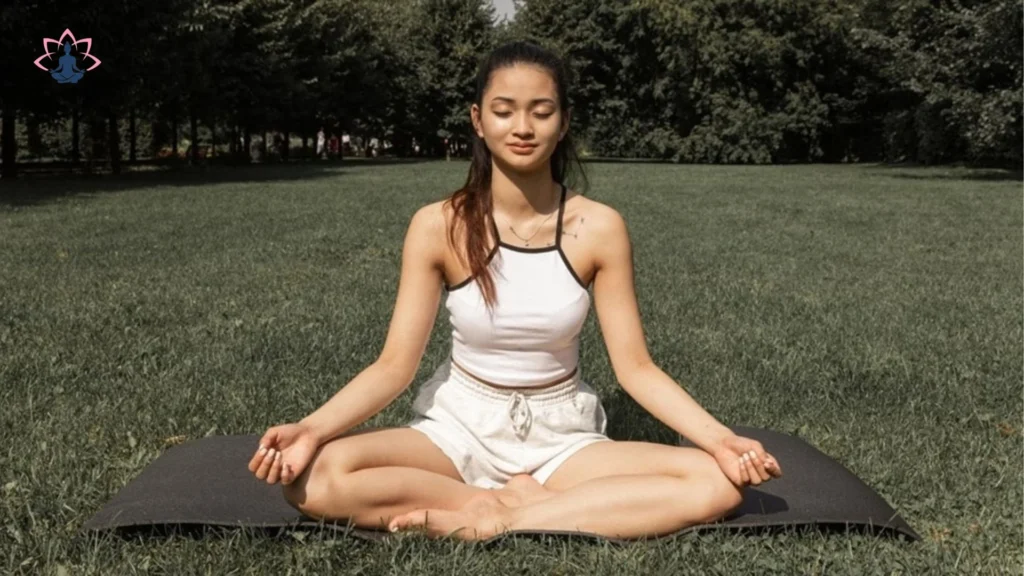
However, we lose out on life’s richness when we are not there. The scent of our dog’s fur when we cuddle, the warmth of the sun against our skin, a loved one’s smile, the taste of dark chocolate as we savor every bite.
There is always a space of calm within us, regardless of how quickly life is passing outside. We may stop searching for peace and tranquility and recognize that it is already here by teaching our minds to live more in the present. Here are seven simple steps to get you started with meditation.
The Seven Simple Steps of Meditation
Living in the past is what depression is all about. You are living in the future if you are concerned. You are living in the now when you are at ease.
Step 1: Find a Comfortable Seated Position
Finding a comfortable seated position is crucial for effective meditation. It helps you maintain focus and avoid distractions caused by discomfort. Here are some tips to help you achieve the perfect seated position:
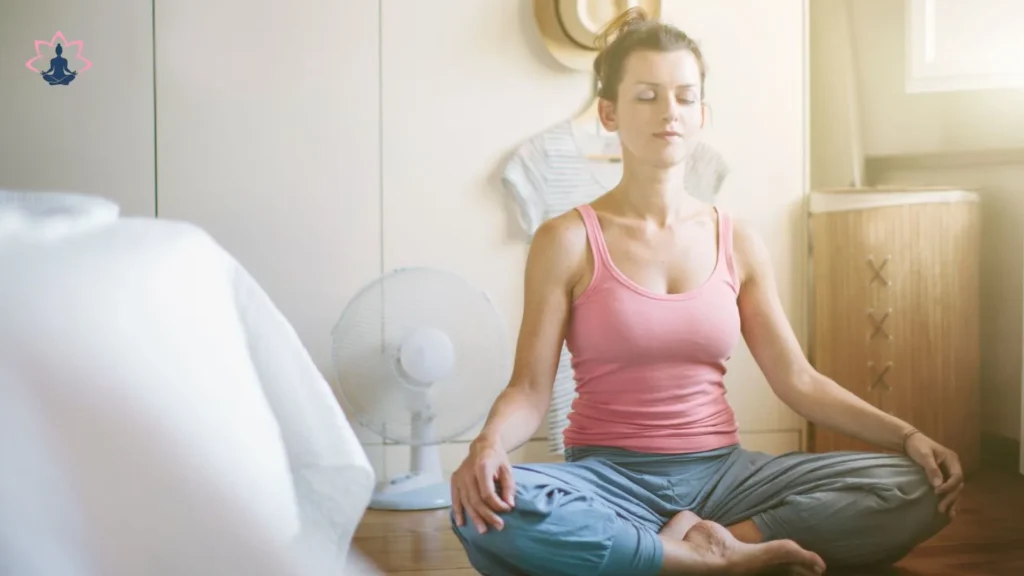
Options for Seating:
- Chair: Sitting in a chair is a great option if you’re new to meditation or have back issues. Ensure your feet are flat on the floor or on a footrest, and your back is straight.
- Cushion or Pillow: Sitting on a cushion or pillow on the floor can help you maintain a straight back. You can sit cross-legged or with your legs tucked under you.
- Meditation Bench: A meditation bench allows you to sit with your back straight while keeping your legs folded under you. It’s ideal for those who find it difficult to sit cross-legged.
Key Points to Consider:
- Posture: Keep your back straight to facilitate easy breathing and maintain focus. A straight back also helps prevent drowsiness.
- Support: If needed, use a back support or a wall to help maintain your posture.
- Comfort: Ensure your position feels comfortable and sustainable for the duration of your meditation session.
Meditation Tips for Beginners:
- Experiment: Try different positions to see what works best for you.
- Adjust as Needed: Don’t hesitate to adjust your position if you feel uncomfortable during meditation.
- Prioritize Comfort: The goal is to be comfortable enough to focus on your meditation without distractions.
- By finding a comfortable seated position, you set the foundation for a successful meditation practice that enhances your mental clarity and relaxation.
See also: A Complete Guide to the 7 Chakras
Step 2: Close Your Eyes
Closing your eyes during meditation is a simple yet effective way to enhance your practice. It helps you focus inward, reduce external distractions, and deepen your connection with your inner self. Here’s how closing your eyes can benefit your meditation:

Benefits of Closing Your Eyes:
- Reduces Distractions: Closing your eyes minimizes visual distractions, allowing you to focus more easily on your breath, thoughts, or meditation object.
- Enhances Introspection: By blocking out external visual stimuli, you can turn your attention inward, exploring your thoughts, emotions, and physical sensations more deeply.
- Promotes Relaxation: Closing your eyes can help signal to your body that it’s time to relax and unwind, which can lead to a deeper state of calm.
Tips for Closing Your Eyes:
- Gently Close: Close your eyes gently without squeezing them shut. This helps maintain relaxation and avoids tension.
- Soft Focus: If you find it difficult to close your eyes completely, you can keep them lightly closed or focus on a point in front of you without looking directly at it.
- Stay Relaxed: Keep your facial muscles relaxed to prevent any unnecessary tension.
Common Challenges and Solutions:
- Difficulty Relaxing: If you feel tense, take a few deep breaths and focus on the sensation of the air moving in and out of your body.
- Mind Wandering: When your mind wanders, gently bring your focus back to your breath or meditation object without judgment.
Step 3: Deep Breathing
Breathing deeply is a crucial step in meditation, as it helps calm the mind, relax the body, and anchor you in the present moment. Deep breathing can transform your meditation practice by enhancing focus, reducing stress, and promoting overall well-being.
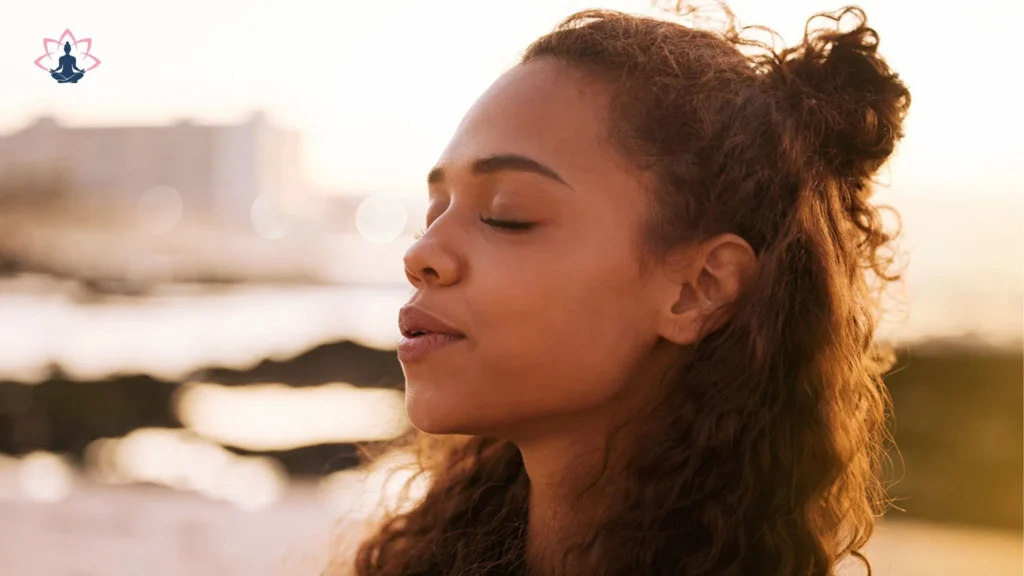
Benefits of Deep Breathing:
- Calms the Mind: Deep breathing slows down your heart rate and calms your nervous system, helping to quiet the mind and reduce racing thoughts.
- Relaxes the Body: Deep breaths release tension in the muscles, leading to a more relaxed and comfortable state.
- Enhances Focus: Focusing on your breath helps maintain concentration and prevents your mind from wandering.
How to Breathe Deeply:
- Inhale Slowly: Breathe in slowly through your nose, allowing your lungs to fill completely. Feel your chest and belly rise as you inhale.
- Hold Briefly: Hold your breath for a brief moment to allow your body to absorb the oxygen.
- Exhale Slowly: Exhale slowly through your mouth or nose, feeling your body relax as you release the air.
Tips for Effective Deep Breathing:
- Count Your Breaths: Counting your breaths can help maintain focus. Try inhaling for a count of four, holding for a count of two, and exhaling for a count of four.
- Use a Mantra: If counting feels too structured, use a simple mantra like “inhale, exhale” to keep your focus on your breath.
- Practice Regularly: Regular practice will help you become more comfortable with deep breathing and improve your ability to focus during meditation.
Common Challenges and Solutions:
- Difficulty Focusing: If your mind wanders, gently bring your attention back to your breath without judgment.
- Feeling Dizzy: If you feel dizzy, slow down your breathing or take a break to breathe normally for a few moments.
Step 4: Scan Your Body
Scanning your body is a mindfulness practice that involves paying attention to different parts of your body, noticing sensations, and releasing tension. This technique is often used in body scan meditation to promote relaxation, reduce stress, and increase body awareness.
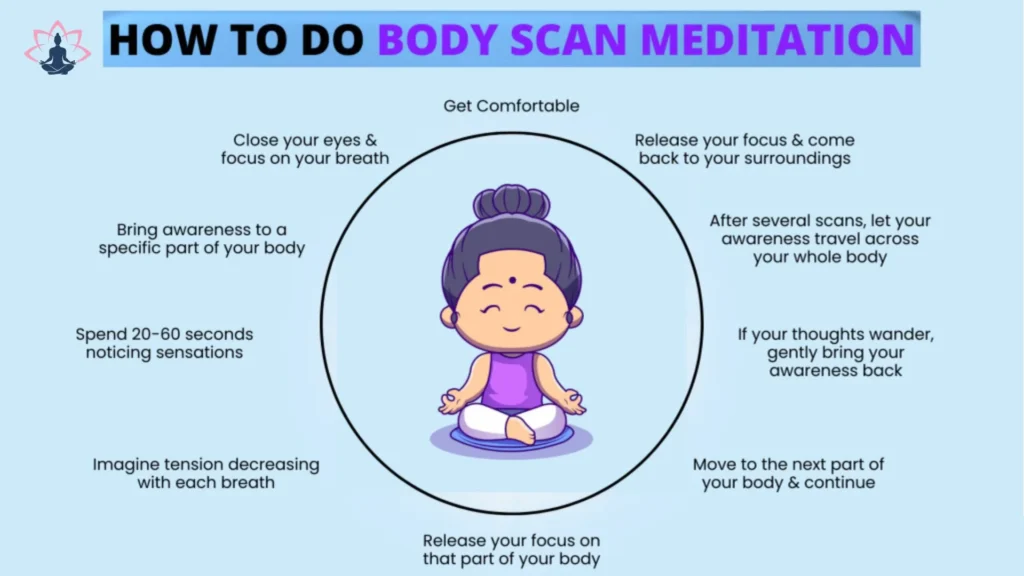
How to Scan Your Body:
- Start at Your Feet: Begin by focusing on your toes, noticing any sensations such as warmth, coolness, or pressure. Gradually move your attention up through your feet, ankles, calves, and knees.
- Move Upward: Continue scanning your body, paying attention to your thighs, hips, lower back, abdomen, chest, shoulders, arms, hands, neck, and finally your head. Notice any sensations, tension, or relaxation in each area.
- Maintain Awareness: As you scan, maintain a non-judgmental awareness of your body. If you encounter areas of tension, acknowledge them without trying to change them. Instead, focus on your breath and visualize any tension leaving your body as you exhale.
Tips for Effective Body Scanning:
- Stay Present: Keep your focus on the present moment, observing your body without judgment.
- Breathe Deeply: Use deep breathing to help relax and focus your attention.
- Be Gentle: Approach your body scan with kindness, avoiding any self-criticism or pressure to achieve a specific state.
Common Challenges and Solutions:
- Difficulty Focusing: If your mind wanders, gently bring your attention back to the part of your body you were focusing on.
- Feeling Tension: When you encounter tension, breathe into it and imagine it releasing as you exhale.
Benefits of Body Scanning:
- Reduces Stress: Body scanning helps release physical tension and promotes relaxation.
- Improves Body Awareness: Regular practice increases your awareness of your body’s sensations and needs.
- Enhances Sleep: By reducing stress and promoting relaxation, body scanning can improve sleep quality.
Step 5: Observe Your Thoughts
Observing your thoughts is a crucial step in meditation, as it helps you develop mindfulness and reduce mental chatter. By learning to observe your thoughts without judgment, you can cultivate a sense of inner peace and clarity.
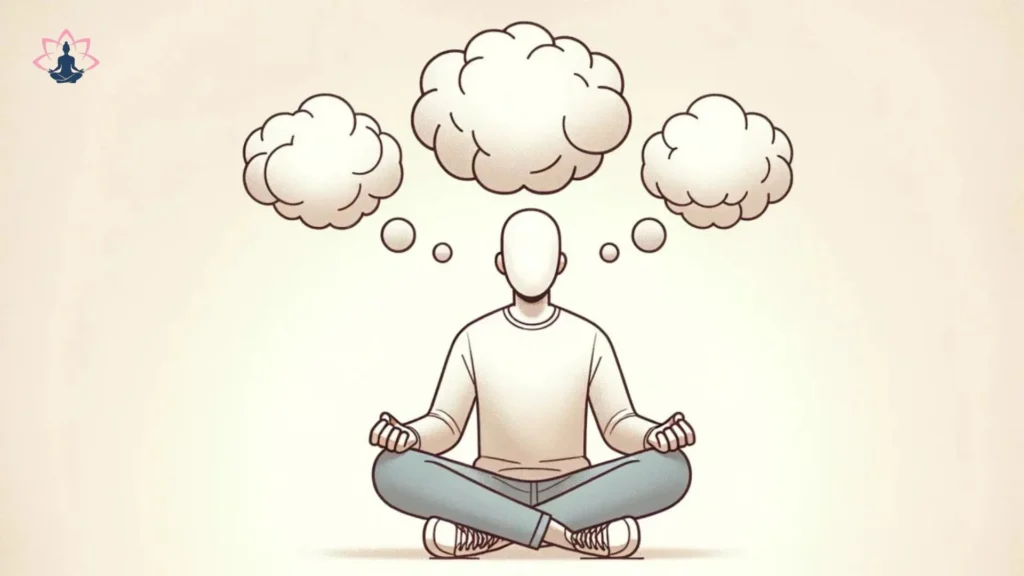
How to Observe Your Thoughts:
- Observe Thoughts: Whenever a thought occurs, accept it without passing judgment. Recognize it as just a thought, rather than becoming engaged with it.
- Label Thoughts: You can label thoughts as “thinking” or “distraction” to help detach from them.
- Let Thoughts Pass: Allow thoughts to pass without engaging with them. Picture them drifting out into the sky like clouds.
Tips for Effective Thought Observation:
- Stay Neutral: Maintain a neutral attitude towards your thoughts. Refrain from evaluating them as excellent or negative.
- Focus on the Breath: If your mind wanders, gently bring your focus back to your breath or a chosen meditation object.
- Practice Patience: Be patient with yourself. The ability to observe ideas objectively takes time, and it’s normal for the mind to stray.
Common Challenges and Solutions:
- Difficulty Detaching: If you find it hard to detach from thoughts, try visualizing them as bubbles floating away or as words written on a chalkboard being erased.
- Feeling Frustrated: If frustration arises, acknowledge it and gently refocus on your breath without judgment.
Benefits of Observing Thoughts:
- Reduces Mental Clutter: By observing thoughts without engaging with them, you can reduce mental chatter and increase clarity.
- Enhances Mindfulness: Regular practice helps develop mindfulness, allowing you to stay present and focused.
- Improves Emotional Regulation: Observing thoughts without judgment can help you manage emotions more effectively.
Step 6: Focus on Your Breath
Focusing on your breath is a fundamental aspect of meditation, as it helps anchor your mind in the present moment, reduce distractions, and cultivate a sense of calm and clarity. Here’s how you can effectively focus on your breath during meditation:
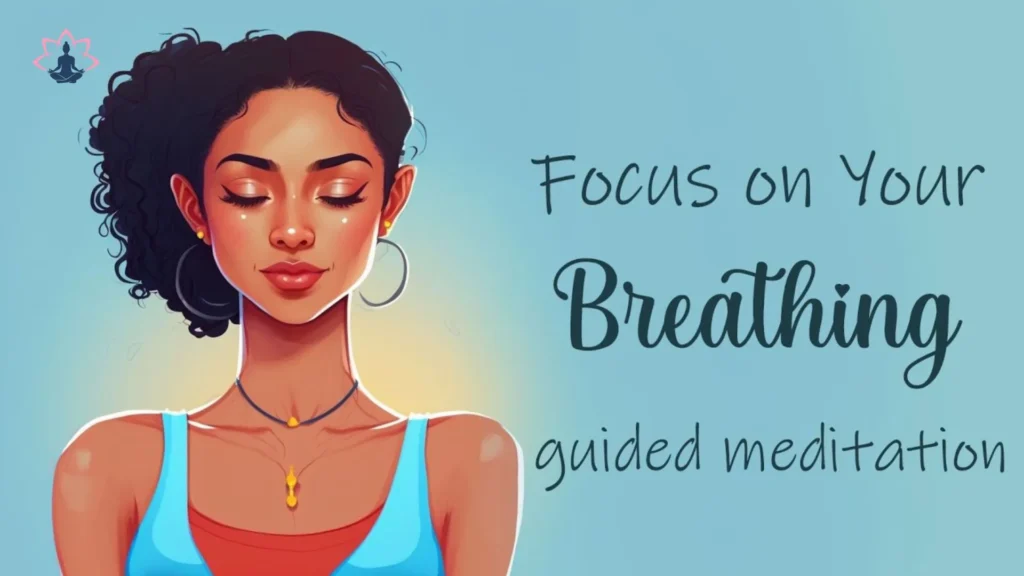
How to Focus on Your Breath:
- Bring Attention to the Breath: Gently shift your focus to your breath, noticing the sensation of the air moving in and out of your nostrils.
- Notice the Sensations: Pay attention to the sensations of each breath, such as the feeling of the air entering and leaving your nostrils, the rise and fall of your chest, or your belly’s growth and contraction.
- Maintain Consistency: Continue focusing on your breath without trying to control it. Allow it to flow naturally.
Tips for Effective Breath Focus:
- Employ a Mantra: A straightforward mantra such as “inhale, exhale” will help you stay focused if your thoughts stray.
- Count Your Breaths: Counting your breaths can also help keep your mind focused. Try taking four breaths and letting them out for four counts.
- Be Gentle: Approach your breath with kindness. If your thoughts stray, gently and impartially draw them back to the present.
Common Challenges and Solutions:
- Difficulty Staying Focused: If you find it hard to stay focused, try to concentrate on a specific sensation, such as the sensation of the breath at the tip of your nose.
- Feeling Restless: If you feel restless, take a few deep breaths and remind yourself that it’s okay for your mind to wander. Gently refocus on your breath.
Benefits of Focusing on the Breath:
- Reduces Stress: Focusing on the breath can calm the nervous system and reduce stress.
- Improves Concentration: Regular practice enhances your ability to focus and maintain concentration.
- Enhances Mindfulness: By anchoring your attention on the breath, you cultivate mindfulness and increase awareness of the present moment.
Step 7: Gradually Open Your Eyes
Gradually opening your eyes is the final step in a meditation session, marking the transition from a meditative state back to your daily activities. This step helps you integrate the calm and clarity you’ve cultivated during meditation into your daily life.
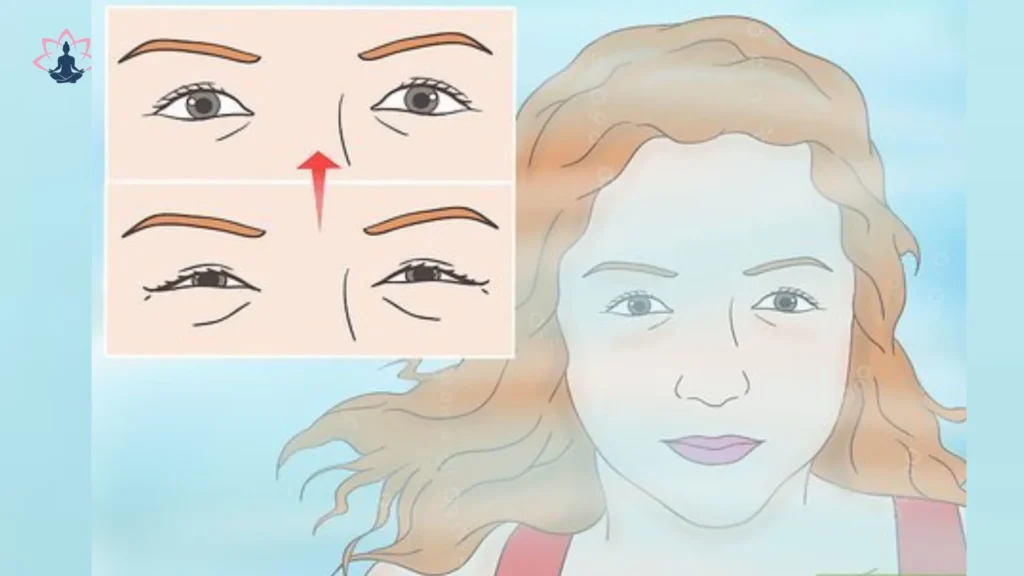
How to Gradually Open Your Eyes:
- Take a Moment to Reflect: Before opening your eyes, take a few deep breaths and reflect on how you feel. Observe any changes in your body or mind.
- Slowly Open Your Eyes: Gently open your eyes, starting with a slight opening and gradually increasing until they are fully open.
- Take a Moment to Adjust: Allow yourself a moment to adjust to the light and your surroundings. Take a few more deep breaths to fully ground yourself.
Tips for a Smooth Transition:
- Stay Calm: Try to maintain the sense of calm and clarity you’ve achieved during meditation as you transition back to your daily activities.
- Carry the Feeling Forward: Intentionally carry the feelings of relaxation and focus into your daily tasks to enhance productivity and well-being.
- Practice Regularly: Regular meditation practice will help you integrate these feelings more smoothly into your daily life.
Common Challenges and Solutions:
- Feeling Drowsy: If you feel drowsy, take a few deep breaths and stretch gently to help increase alertness.
- Difficulty Maintaining Calm: If you find it hard to maintain the calm feeling, remind yourself that it’s normal for the mind to wander. Take some time to concentrate and take a big breath.
Benefits of Gradually Opening Your Eyes:
- Smooth Transition: Gradually opening your eyes helps you transition smoothly from a meditative state to your daily activities.
- Integrates Benefits: This step helps integrate the benefits of meditation, such as calmness and clarity, into your daily life.
- Enhances Mindfulness: By taking a moment to reflect and adjust, you cultivate mindfulness and increase awareness of your thoughts and emotions.
Meditation as a Supportive
It’s crucial to start small and meditate for five to ten minutes at first. In the morning, before consuming coffee or other stimulants, is the ideal time of day to meditate. You may progressively extend your meditation sessions as you get more accustomed to it.
Sitting on a pillow is not the only way to practice meditation. It is a tool that you may use all day long. You can still engage in mindful breathing during a meeting, a traffic jam, or a discussion even if you don’t have time to close your eyes and meditate. Regular meditation practice will improve your ability to manage stress and achieve inner calm in your daily life.
Tips for Beginners:
- Start Small: As you get more accustomed to meditation, progressively extend the length of your sessions from five to ten minutes.
- Have patience: Your thoughts wandering is natural. Without passing judgment on yourself, gently bring your attention back to your breathing.
- Employ Guided Meditations: These may be quite beneficial for novices. They are available on applications such as Calm and Headspace.
Conclusion
By improving mental clarity, lowering stress levels, and fostering general well-being, meditation is a straightforward yet effective technique that may change your life. You may start your meditation journey and reap the many benefits by following these seven easy steps. Keep in mind that consistency is essential, so begin with a little exercise and progressively expand it as you gain confidence. Meditation is a flexible tool to support your objectives, whether you’re looking to increase your attention, find greater tranquility in your everyday life, or better your mental health.
FAQ
What if I find it hard to focus during meditation?
What if I find it hard to focus during meditation?
It’s normal for your mind to wander. Simply acknowledge the thought and gently bring your focus back to your breath without judgment.
How long should I meditate each day?
How long should I meditate each day?
Start with short sessions of 5-10 minutes and gradually increase as you become more comfortable with the practice.
Can I meditate anywhere?
Can I meditate anywhere?
Yes you can meditate anywhere, even during daily activities like walking or showering. Use mindfulness to bring meditation into your daily routine.
Do I need any special equipment for meditation?
Do I need any special equipment for meditation?
No, you don’t need any special equipment. A quiet space and a comfortable sitting position are all you need to start meditating.
How often should I meditate?
How often should I meditate?
Aim to meditate regularly, ideally once or twice a day. Consistency is key to experiencing the benefits of meditation.